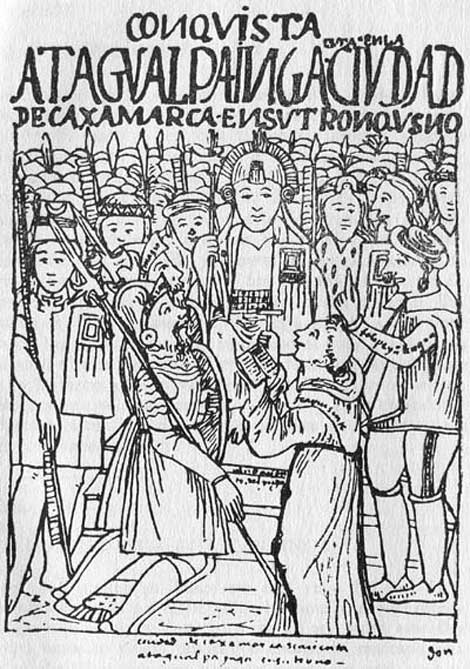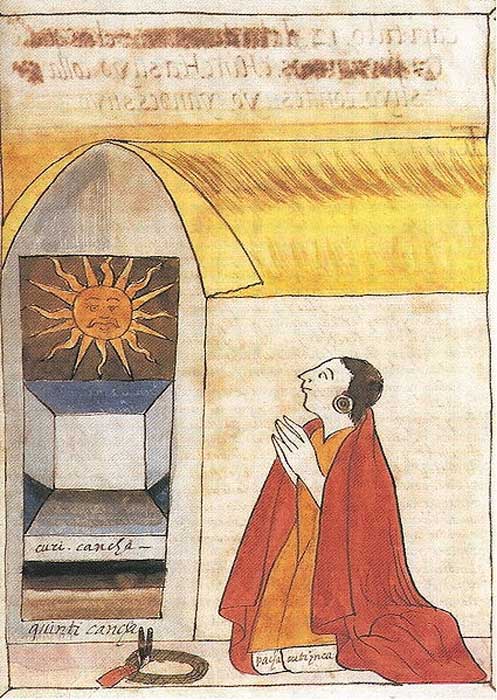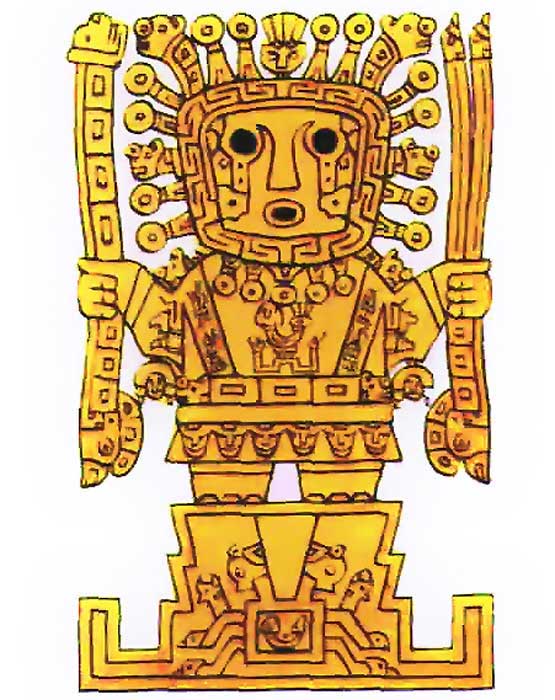
Viracocha’s ‘Sweat and Tears’ – Three Supreme Deities of the Incan Religion
Every year, the people of Peru host an elaborate celebration in the city of Cuzco at the time of the summer solstice. This festival is known as Inti Raymi – the Festival of the Sun. To spectators, this celebration may seem like mere entertainment. But it may provide one of the only insights available today about the worship practices of the powerful, ancient leaders who once ruled the region known as the Inca Empire.
The Spanish Encounter the Incas
When Francisco Pizarro accepted the commission from the Spanish Crown to make an expedition to the New World, it can be assumed that he was thrilled with the prospect of acquiring fame and fortune from this expedition. Like his predecessors, he probably set sail with the pre-conceived notion that upon safely arriving in the New World, he would encounter small, roaming bands of un-Christian, uncivilized people.

Francisco Pizarro meets with the Inca emperor Atahualpa, 1532. Illustration by Waman Puma de Ayala in the early 17th century. (Public Domain)
When Pizarro and his crew encountered the Incas, they were shocked to find a society of people busy performing very organized and sophisticated rituals similar to those performed at modern-day sun festivals. The Spaniards’ encounter with the Incas would have been shocking because it contrasted with the beliefs that they held about the people being small, un-Christian, and uncivilized. Pizarro would have been somewhat correct in his bias; however. The Incas were un-Christian people, but they were far from small and uncivilized. From one account of one of the conquistadors that traveled with Pizarro, Pedro de Cieza de Leon, who described the lands of the Incas in his journal:
“This [kingdom of the Incas] was so well-organized that there was not a village that did not know where it was to send its tribute. In all these capitals the Incas had temples of the Sun, mints, and silversmiths who did nothing but work rich pieces of gold or fair vessels of silver...this kingdom was so vast, in each of the many provinces, there were many storehouses filled with supplies and other needful things.”
- Inti, Sun God of the Inca, Spawned the First Rulers of An Unforgettable Empire
- Ancient Inca Festival Celebrating Sun God, Once Practiced in Secret, is Revived in Peru
- Viracocha's Astronomical Creation Engine

The first image of the Inca in Europe, Pedro Cieza de León, ‘Cronica del Peru’, 1553. (Public Domain)
Although Pizarro may have been shocked initially, he may have also been relieved to see how organized and sophisticated their worship practices were. The Incas were obviously devoted to their gods and goddesses because religion permeated every aspect of their life. So, the Incas did not need to be coerced into the act of worship; the Spanish only needed to force the Incan people to pledge allegiance to and provide as much devotion to the Catholic god and abandon their pagan ones.
But what gods were the Incas worshipping that required so much devotion and sacrifice of foodstuffs, gold, and silver – sacrifices offered to pagan gods which were only fit for a Christian god?

17th century illustration by Martín de Murúa of the Inca Pachacútec praying to Inti, the sun god. ( Public Domain)
Viracocha – Creator of all Things
The Inca believed in a supreme deity called Viracocha, who was neither male nor female. The deity, whose name literally translates as “Sea Foam,” arose from Lake Titicaca to create all things, including the lesser gods within the pantheon of the Incan gods and goddesses.
After Viracocha created everything, the Incans believed it retreated from earthly affairs, handed the reins over to the sun and the moon, and disappeared into the sea, leaving behind a promise that it would return. Although Viracocha was recognized as the chief deity of all Incan gods, it wasn’t worshipped as intently as other deities in the pantheon.

Viracocha. ( Public Domain)
Inti and Mama Killa – God of Sweat, Goddess of Tears
Inti and Mama Killa were two other chief deities of Inca veneration. These two deities were complementary to one another as Incas believed in a duality in all things. Inti was the sun god and it was believed that his sweat gave the Inca people their enormous stores of gold. Mama Killa was the moon goddess and it was believed that she gave the Inca people silver through her tears.
A special class of trained people known as orjones and acllas, whose only job was to appease the gods, cared for and worshipped these deities in the Coricancha, the temple of the sun. This spectacular place of worship was filled with golden statues, including the large sun-disk which shone brightly when the sun aligned with it during the solstices. The golden portion of the Coricancha was dedicated to Inti and the silver side was dedicated to Mama Killa. The Inca worshipped Inti and Mama Killa regularly – that is, until the arrival of the Spanish.

Coricancha, the Temple of the Sun, was destroyed by the conquistadors and used to build a church. The original Inca stones can still be seen at the base of the church. ( Terry Feuerborn /CC BY NC 2.0 )
Inca Deity Worship Continues
Although over eighty percent of today’s Peruvian population is Roman Catholic, the on-going legacy of this annual festival demonstrates that the Inca beliefs and way of life weren’t entirely wiped out by Spanish conquest.
- Origin Myths of the Inca Civilization & Piecing Together Royal Heritage
- Who Built the Fascinating Ñaupa Iglesia? Mysterious Ruins in the Sacred Valley of Peru
- Sun and Earth Aligned: Ancient Andean Calendar is Illuminated on the Atacama Desert
The Inca did not have a written language, so they did not leave behind their own written accounts of their culture or worship practices. Much of what is known about their past lies in what the Spanish said about them in their journals and artifacts being unearthed by archaeologists.

Drawings by Guamán Poma de Ayala showing the planting of potatoes and other tubers ( Public Domain) and their harvest. ( Public Domain) Note the presence of Inti in the top left and Mama Quilla in the top right of the first drawing and only Inti in the second.
Historians and archeologists are determined to discover what life was like not only when the Spanish arrived but also long before the Spanish conquests. But historians and archeologists aren’t the only ones who want to know more about the ancient people of this region. Peruvian people themselves are trying to piece together their own past by learning more about the gods and goddesses that once reined over their people and this is best demonstrated through the unwritten customs seen in their modern-day cultural festivals.

Inti Raymi at Saksaywaman, Cusco. ( CC BY SA 3.0)
Top Image: Viracocha (GENZOMAN /Deviant Art), Mama Killa, (GENZOMAN /Deviant Art) and Inti. (el-grimlock/Deviant Art)
By M. L. Childs
References
Arkenberg, Jerome, Barton, Richard, Blackmon, Robert and et al. Modern History Sourcebook [online]. “Pedro de Cieza de Léon: Chronicles of the Incas, 1540,” Retrieved on July 24, 2018.
Malpass, Michael A., Daily Life in the Inca Empire. Greenwood Press: Westport, 1996.
Marrin, Albert, Inca and Spaniard: Pizarro and the Conquest of Peru. MacMillan Publishing Company: New York, 1989.
Visit Peru. Inti Raymi 2015. Youtube. Retrieved on July 31, 2018.















